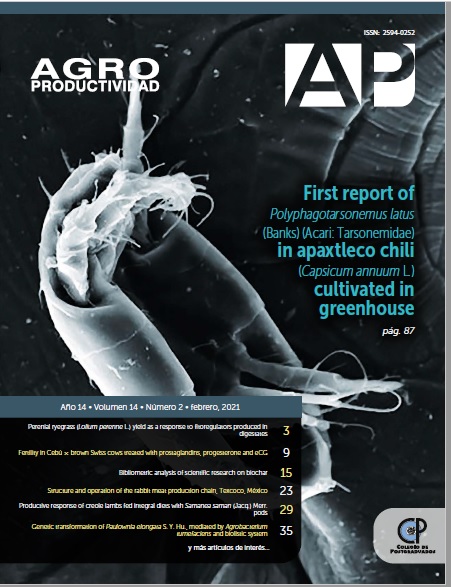Mycelial disturbance stimulates the formation of sporomes of edible ectomycorrizhal fungi associated with two neotropical pines Micelial disturbance estimulates edible ectomycorrhizal mushrooms
##plugins.themes.bootstrap3.article.main##
Keywords
spore inoculum, ectomycorrhizal symbiosis, wild edible fungi, mycelial disturbance
Resumen
Objective: To determine the effect of mycelial disturbance on the formation of sporomes
of two edible ectomycorrhizal fungi of great biocultural relevance in Mexico (Laccaria
laccata and Hebeloma leucosarx) associated to two Neotropical pines with economic
and ecological importance, Pinus greggii and P. montezumae.
Design/Methodology/Approach: Spore inoculum was produced using ground pilei of
the evaluated ectomycorrhizal fungi; each pine plant was inoculated with 10 7 to 10 8
fungal spores. A completely randomized experimental design was used with four
treatments and six replicates per treatment for each pine species, having a total of 48
experimental units, each one consisting in an inoculated tree. During two years the
sporome production was evaluated in the treatments with and without mycelial
disturbance. The duration of the experiment, since seed germination, was 5 years.
Results: The mycelial disturbance originated a higher formation of sporomes in both
fungal species, regardless of the associated tree species. The highest sporome
formation was recorded in plants inoculated with H. leucosarx compared to those inoculated with L. laccata in both pine species. Mycelial disturbance, originated a higher
number of sporomes in Pinus greggii compared to P. montezumae.
Study Limitations/Implications: The evaluation of factors influencing sporome
formation in edible ectomycorrhizal fungi requires long term experiments.
Findings/Conclusions: This study shows for the first time that mycelial disturbance
increases sporome formation in Neotropical ectomycorrhizal fungi. Additionally, a
differential influence of the fungal and tree species on the number of produced
sporomes was found. These findings shed some light on potential cultivation methods
for edible ectomycorrhizal mushrooms.

